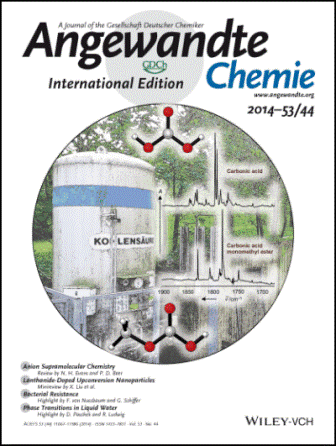Gas phase preparation of carbonic acid and its monomethyl ester.
Hans Peter Reisenauer, Jan Philipp Wagner, Peter R. Schreiner
Angew. Chem. Int. Ed. 2014, 53, 11766–11771 (“hot paper”), DOI: 10.1002/anie.201406969.
Highlights:
a) Front cover of this issue;
b) Perspective: Götz Bucher and Wolfram Sander Science 2014, 346, 544–545; c) Feature: Carbonic Acid Crystal Forms Identified. Jyllian N. Kemsley C & EN News 2014, 92 (41), 28–29;
d) ChemistryViews: Carbonic Acid – And Yet It Exists!;
e) Innovations Report: Carbonic Acid—And Yet It Exists!;
f) Physorg.com: Preparation and characterization of gas-phase carbonic acid and its monomethyl ester.
 Carbonic acid (H2CO3), an essential molecule of life (e.g., as bicarbonate buffer), has been well characterized in solution and in the solid state, but for a long time, it has eluded its spectral characterization in the gas phase owing to a lack of convenient preparation methods; microwave spectra were recorded only recently. Here we present a novel and general method for the preparation of H2CO3 and its monomethyl ester (CH3OCO2H) through the gas-phase pyrolysis of di-tert-butyl and tert-butyl methyl carbonate, respectively. H2CO3 and CH3OCO2H were trapped in noble-gas matrices at 8 K, and their infrared spectra match those computed at high levels of theory [focal point analysis beyond CCSD(T)/cc-pVQZ] very well. Whereas the spectra also perfectly agree with those of the vapor phase above the β-polymorph of H2CO3, this is not true for the previously reported α-polymorph. Instead, the vapor phase above α-H2CO3 corresponds to CH3OCO2H, which sheds new light on the research that has been conducted on molecular H2CO3 over the last decades.
Carbonic acid (H2CO3), an essential molecule of life (e.g., as bicarbonate buffer), has been well characterized in solution and in the solid state, but for a long time, it has eluded its spectral characterization in the gas phase owing to a lack of convenient preparation methods; microwave spectra were recorded only recently. Here we present a novel and general method for the preparation of H2CO3 and its monomethyl ester (CH3OCO2H) through the gas-phase pyrolysis of di-tert-butyl and tert-butyl methyl carbonate, respectively. H2CO3 and CH3OCO2H were trapped in noble-gas matrices at 8 K, and their infrared spectra match those computed at high levels of theory [focal point analysis beyond CCSD(T)/cc-pVQZ] very well. Whereas the spectra also perfectly agree with those of the vapor phase above the β-polymorph of H2CO3, this is not true for the previously reported α-polymorph. Instead, the vapor phase above α-H2CO3 corresponds to CH3OCO2H, which sheds new light on the research that has been conducted on molecular H2CO3 over the last decades.
